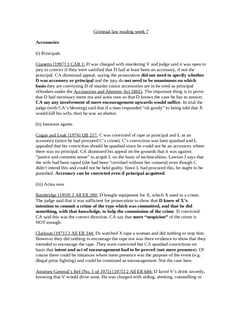R v Lipman [1970] 1 QB 152; [1969] 3 WLR 819; [1969] 3 All ER 410
Judgement for the case R v Lipman
Table Of Contents
KEY POINTS
-
Crime encompasses various unlawful activities, with homicide being a severe offense involving the unlawful killing of another person.
Manslaughter, a subset of homicide, typically lacks premeditation.
Mens rea, or the guilty mind, is crucial in determining the defendant's intent during the crime, especially homicide cases.
-
The connection between an unlawful act and resulting death is pivotal, particularly when the defendant is intoxicated by self-induced drug use.
Questions arise about whether specific intent must be proven for a conviction, and debates on the inevitability of a manslaughter verdict add complexity to these cases.
The Criminal Justice Act of 1967, Section 8, guides legal proceedings regarding intent, evidence admissibility, and offense categorization.
FACTS
-
In this case, the killing resulted from an unlawful act committed by Robert Lipman (“Defendant”).
Notably, the legal precedent in this matter dictated that specific intent did not have to be proven for a manslaughter conviction.
Consequently, the defense of self-induced intoxication, particularly by drugs such as L.S.D., was not considered a valid defense.
The circumstances of the case involved the Defendant, while under the influence of L.S.D. voluntarily taken, engaging in acts that were evidently likely to cause harm to the victim, who ultimately lost their life.
Despite being initially charged with murder, the Defendant was convicted of manslaughter.
Subsequently, an appeal against this conviction was lodged, prompting further legal scrutiny and deliberation on the grounds of the appeal.
JUDGEMENT
In the judgment, the court held, dismissing the appeal, that an acquittal was impossible and a verdict of manslaughter, at least, was inevitable.
-
The decision was rendered per curiam.
The court emphasized that for the purpose of criminal responsibility, there was no valid reason to distinguish between the effect of drugs voluntarily taken and drunkenness voluntarily induced.
-
Furthermore, the court acknowledged that manslaughter remains a challenging offense to define due to its manifestation in various circumstances.
Given the wide range of ways in which manslaughter can occur, and the varying mental elements (if any) required to establish it, any general reference to mens rea was deemed apt to mislead.
Therefore, the court underscored the complexity surrounding manslaughter cases and the need for nuanced consideration of the circumstances.
COMMENTARY
-
The case highlights the general legal framework surrounding crime, specifically homicide and manslaughter, emphasizing the importance of mens rea in determining the Defendant's intent.
It acknowledges the complexity arising from the connection between unlawful acts and resulting deaths, especially in cases involving self-induced intoxication.
The mention of ongoing debates and the role of the Criminal Justice Act of 1967 provides a broader context for understanding the legal issues.
-
In the case of Robert Lipman, the court ruled that specific intent was not necessary for a manslaughter conviction, rejecting the defense of self-induced intoxication.
The circumstances involving L.S.D. use and acts likely to cause harm highlight the process of determining culpability.
The initial murder charge, subsequent manslaughter conviction, and lodged appeal underscore the legal complexities inherent in such cases.
The court's judgment reinforces the inevitability of a manslaughter verdict, dismissing the appeal and emphasizing the lack of distinction between the effects of voluntarily taken drugs and voluntarily induced drunkenness.
The acknowledgment of manslaughter's difficulty in definition due to varied circumstances and mental elements reflects the nuanced nature of these cases.
For Further Study on R v Lipman
Need instant answers? Our AI exam tutor is here to help.
Ask questions 🙋 Get answers 📔 It's simple 👁️👄👁️
Our AI is educated by the highest scoring students across all subjects and schools. Join hundreds of your peers today.
Get StartedRelated Product Samples
These product samples contain the same concepts we cover in this case.
| Criminal Law | Homicide Notes (7 pages) |
| Criminal Law | Homicide Notes (20 pages) |

